Micronized PTFE Market Size and Share
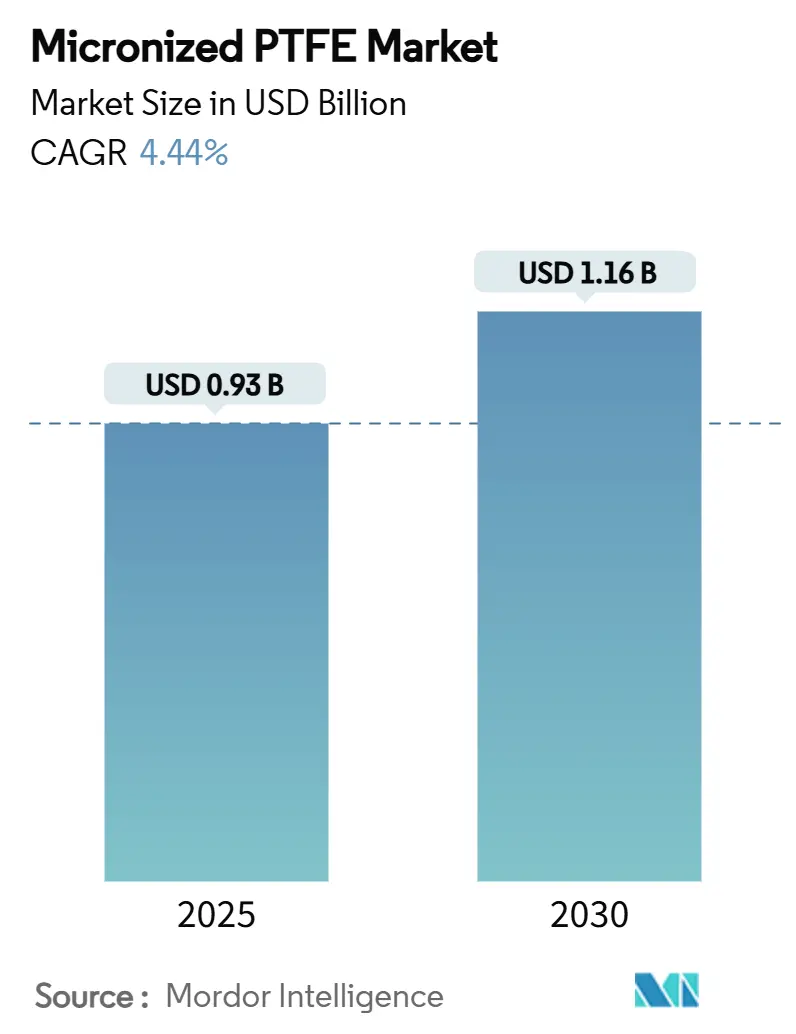
Micronized PTFE Market Analysis by Mordor Intelligence
The Micronized PTFE Market size is estimated at USD 0.93 billion in 2025, and is expected to reach USD 1.16 billion by 2030, at a CAGR of 4.44% during the forecast period (2025-2030). Market growth is underpinned by irreplaceable tribological and chemical-resistance properties that sustain demand in high-performance automotive, electronics, and semiconductor applications despite intensifying PFAS restrictions. Asia-Pacific’s production cost advantages, deep electronics supply chains, and accelerating electric-vehicle build-out keep the region at the forefront of global volume expansion. Meanwhile, rapid uptake of premium coatings, drivetrain lubricants, and additive-manufacturing modifiers underscores a shift away from commodity volumes toward value-added niches. Manufacturers that maintain end-to-end process control and invest in best-in-class emission-capture systems are best placed to navigate tightening compliance regimes while protecting margins.
Key Report Takeaways
- By application, inks and coatings led with 41.34% of the micronized PTFE market share in 2024., while lubricants and grease are projected to expand at a 5.45% CAGR through 2030 within the micronized PTFE market.
- By end-user industry, the automotive and transportation segment commanded 34.61% share of the micronized PTFE market size in 2024 and is set to advance at a 5.86% CAGR through 2030.
- By geography, Asia-Pacific accounted for 46.55% of the micronized PTFE market in 2024, while it is also the fastest-growing region at a 5.61% CAGR to 2030.
Global Micronized PTFE Market Trends and Insights
Driver Impact Analysis
| Drivers | (~) % Impact on CAGR Forecast | Geographic Relevance | Impact Timeline |
|---|---|---|---|
| Surging demand for low-friction thermoplastics in automotive and electronics | +1.8% | Global (APAC and North America) | Medium term (2–4 years) |
| Rapid expansion of inks and industrial/packaging coatings | +1.2% | APAC manufacturing hubs | Short term (≤ 2 years) |
| Growing use in EV drivetrain lubricants and industrial greases | +0.8% | North America and EU, APAC scale-up | Long term (≥ 4 years) |
| Rising adoption in elastomer seals and gaskets | +0.6% | Global industrial bases | Medium term (2–4 years) |
| Increasing usage as additive-manufacturing rheology modifier | +0.4% | North America and EU | Long term (≥ 4 years) |
| Source: Mordor Intelligence | |||
Surging Demand for Low-Friction Thermoplastics in Automotive and Electronics
Thermoplastic compounders are increasingly adding micronized PTFE to achieve ultra-low coefficients of friction, which help extend the range of electric vehicles and support the demands for semiconductor miniaturization. Automotive power-electronics housings now incorporate PTFE-modified PEEK or PPS blends that maintain dimensional stability at continuous service temperatures of up to 170 °C, thereby safeguarding inverter reliability. Precision electronic gears and slide mechanisms in lithography equipment use the same approach to mitigate particle generation in cleanrooms[1]Cleanroom Technology, “Air Filtration: Advantages of PTFE Materials,” cleanroomtechnology.com.
Rapid Expansion of Inks and Industrial/Packaging Coatings
Digital presses running at more than 300 m min⁻¹ require wax additives that minimise print-head drag; micronized PTFE fulfils this role by lowering surface energy without clouding transparency. Industrial floorings and metal packaging lines use PTFE-fortified coatings that cut maintenance intervals by up to 40%, aligning with lean manufacturing targets. Reformulated grades meet low-PFOA benchmarks, signalling industry willingness to invest in compliance over wholesale substitution.
Growing Use in EV Drivetrain Lubricants and Industrial Greases
PTFE-enhanced oils slash friction by 47% and extend component life by 62.7% in high-speed e-motors, according to laboratory tribometry data. The United States alone consumes 2.4 billion gallons of vehicle lubricants annually, offering a large conversion base toward PTFE-based formulations. Automation developers deploy similar greases in harmonic drives and ball screws to maintain accuracy under 24/7 duty cycles[2]MDPI Lubricants, “Forever Chemicals in Lubrication,” mdpi.com .
Rising Adoption in Elastomer Seals and Gaskets
Aggressive fluids and rising process temperatures force OEMs to shift from nitrile rubbers to PTFE-filled fluoro-elastomers. For example, Parker has validated PTFE micro-powders that double chemical resistance while retaining 300% elongation at break. Aerospace engine builders rely on these seals to suppress leakage at 500 °F service, avoiding costly in-flight maintenance.
Restraint Impact Analysis
| Restraints | (~) % Impact on CAGR Forecast | Geographic Relevance | Impact Timeline |
|---|---|---|---|
| Intensifying PFAS regulatory scrutiny and potential bans | −0.9% | EU and North America leadership | Short term (≤ 2 years) |
| Volatile TFE-monomer/fluorspar raw-material prices | −0.5% | Global | Medium term (2–4 years) |
| Substitution threat from bio-based/silicone micro-powders | −0.3% | EU leading adoption | Medium term (2–4 years) |
| Source: Mordor Intelligence | |||
Intensifying PFAS Regulatory Scrutiny and Potential Bans
The European Chemicals Agency’s proposal to restrict 10,000 PFAS chemistries would encapsulate most PTFE fine powders by 2026, allowing only “essential-use” derogations for aerospace, medical, and similar critical fields. Parallel United States rules designate PFOA/PFOS as CERCLA hazardous substances, exposing producers to remediation liabilities. Daikin has earmarked USD 300 million to raise wastewater capture efficiency to 99.9% and retain access to Western markets. Insurers such as Lloyd’s now embed PFAS exclusions in general liability policies, likening the risk profile to historical asbestos claims.
Volatile TFE-monomer/Fluorspar Raw-Material Prices
Geopolitical tensions and supply chain disruptions lead to fluctuations in the costs of tetrafluoroethylene monomer and fluorspar feedstock, putting pressure on margins. China's leading role in fluorspar production heightens supply risks. Additionally, the manufacturing of TFE is constrained to specialized facilities, which are limited in number worldwide. Such price volatility complicates long-term contract negotiations, pushing manufacturers to adopt dynamic pricing strategies. While these strategies can help navigate the market, they might also limit penetration in applications sensitive to price changes. Furthermore, the concentrated supply of these raw materials poses strategic challenges for Western manufacturers, who are increasingly prioritizing supply chain resilience and adherence to regulatory standards.
Segment Analysis
By Application: Inks and Coatings Lead Performance-Critical Segments
Inks and coatings held the largest 41.34% share of the micronized PTFE market in 2024. Lubricants and grease, although smaller at 21.27% of 2024 volume, capture the fastest 5.45% CAGR through 2030 as EV scale-up demands superior thermal and dielectric lubricant traits.
Thermoplastics represent a solid mid-tier, with polypropylene, PEEK, and PPS suppliers blending less than or equal to 5 wt% PTFE to achieve friction coefficients of less than 0.15 μ. The micronized PTFE market share for thermoplastics remains stable around underpinned by steady electronics demand. Elastomers rise as oil and gas upgrade exploration equipment to withstand sour-gas corrosion.
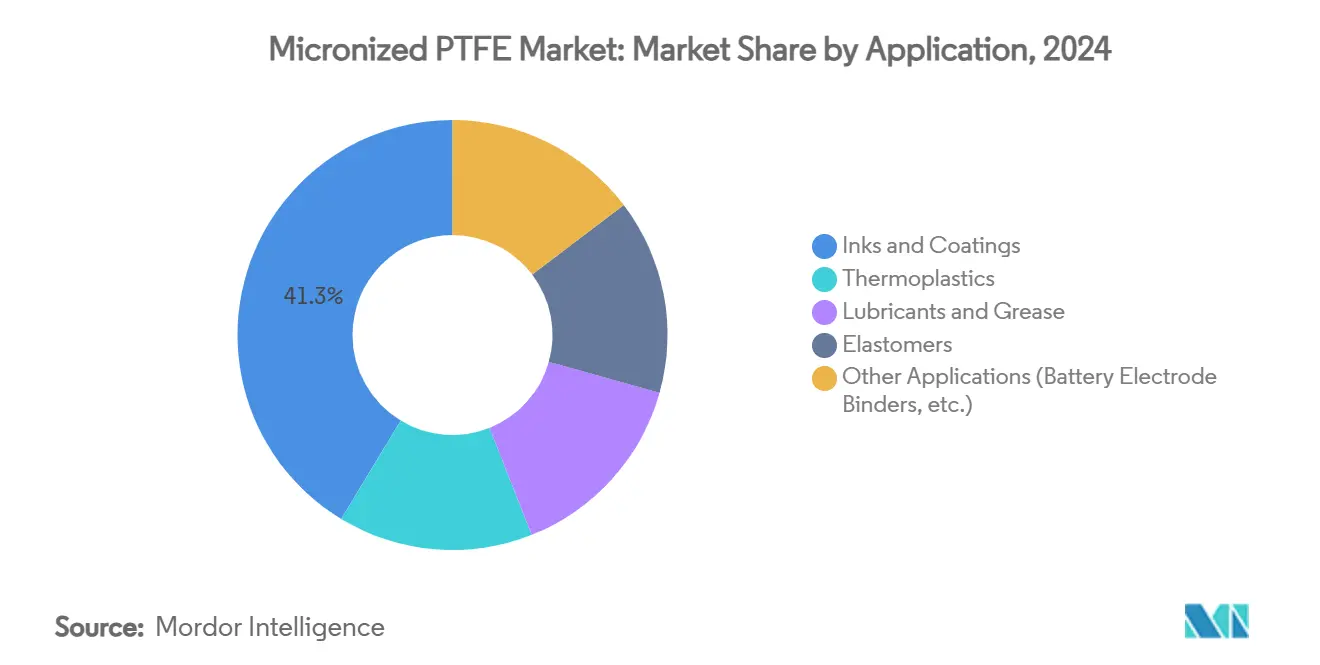
Note: Segment shares of all individual segments available upon report purchase
By End-user Industry: Automotive Drives Both Scale and Innovation
The automotive and transportation sector consumed 34.61% of the global volume in 2024. The segment’s 5.86% CAGR outpaces every other end-user group, lifting the micronized PTFE market size for automotive to USD 0.44 billion by 2030. EV makers specify PTFE-filled thermoplastics for battery pack thermal barriers and copper-foil spacers, while tier-one lubricant formulators lead the switch to fluorinated greases.
The electrical and electronics sector is buoyed by semiconductor fab expansions in Taiwan, South Korea, and the United States' CHIPS-Act corridor. Industrial processing leverages PTFE’s non-stick and chemical inertness in filtration plates and diaphragm pumps. Medical and pharmaceutical uses grow steadily on transplantable device coatings and drug-delivery matrices validated for biocompatibility. Packaging lags due to retailer pressure to move toward PFAS-free barriers, opening an avenue for bio-wax competitors.
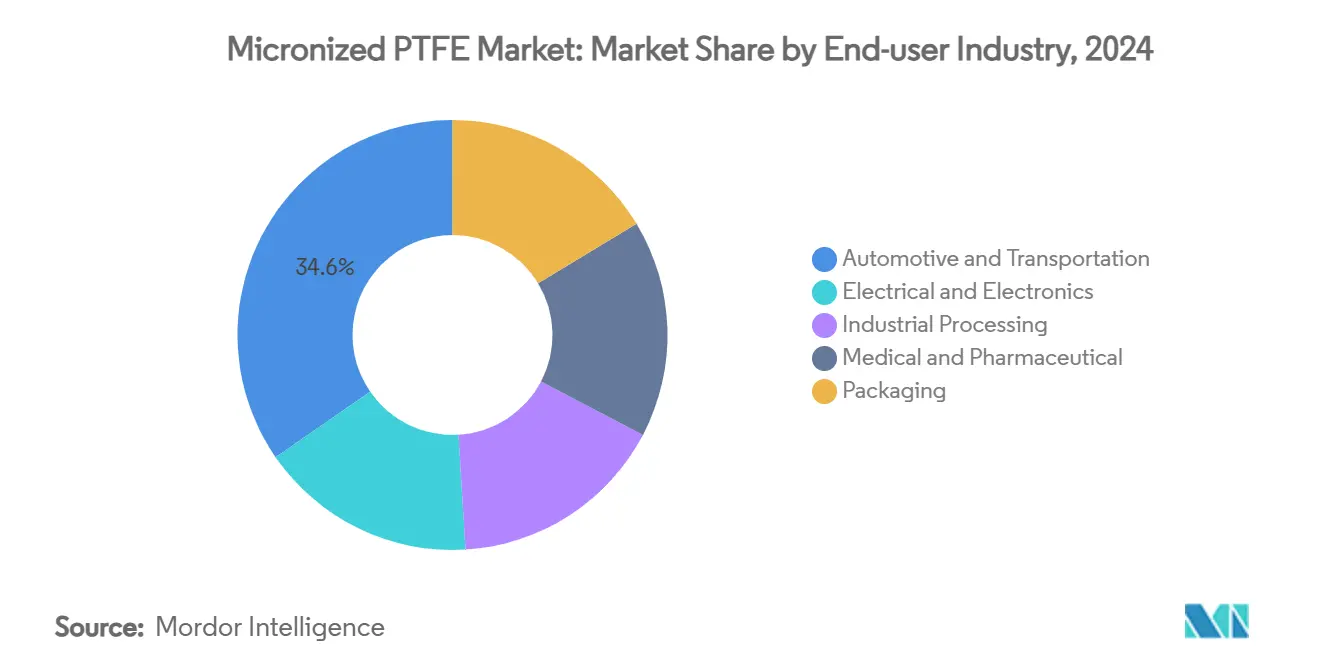
Note: Segment shares of all individual segments available upon report purchase
Geography Analysis
In 2024, the Asia-Pacific region accounted for 46.55% of the micronized PTFE market, with China, Japan, and South Korea collectively controlling 78% of the regional production capacity. The area posts a leading 5.61% CAGR. Government incentives for battery and semiconductor supply chains accelerate local consumption, while exporters benefit from relative cost advantages even after incorporating incremental PFAS-capture investments.
North America’s OEMs benefit from proximity and robust research and development ecosystems, which sustain price premiums. Europe follows but faces the steepest regulatory headwinds. Essential-use exemptions will likely shelter aerospace and medical demand, yet commodity coatings may migrate offshore. South America, the Middle East, and Africa are driven by demand centered on mining, energy, and infrastructure projects that favor durable, low-maintenance materials.
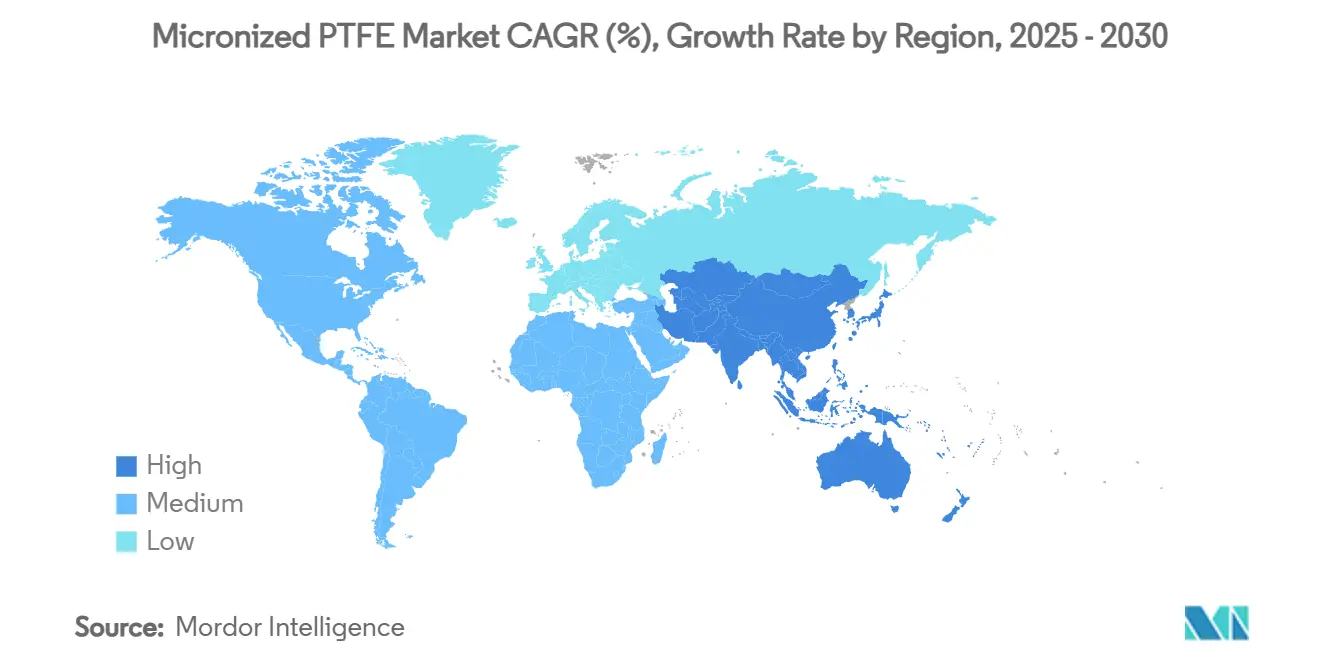
Competitive Landscape
The market is highly consolidated in nature. Daikin’s integrated fluorspar mining, TFE monomer production, and polymerization assets maintain resilient cost positions. Its USD 300 million wastewater abatement project underscores a strategy to stay ahead of compliance curves. Technologies differentiate themselves through proprietary micronization, which achieves a D50 of 4 μm, enabling optical-grade clarity in clear-coat lacquers. Market realignment is visible: Micro Powders will exit PTFE by the end of 2025, citing an inability to justify retrofitting legacy plants, which opens the market share for incumbents ready to supply compliant grades.
Micronized PTFE Industry Leaders
-
3M
-
The Chemours Company
-
DAIKIN INDUSTRIES, Ltd.
-
Shamrock Technologies Inc.
-
Syensqo
- *Disclaimer: Major Players sorted in no particular order
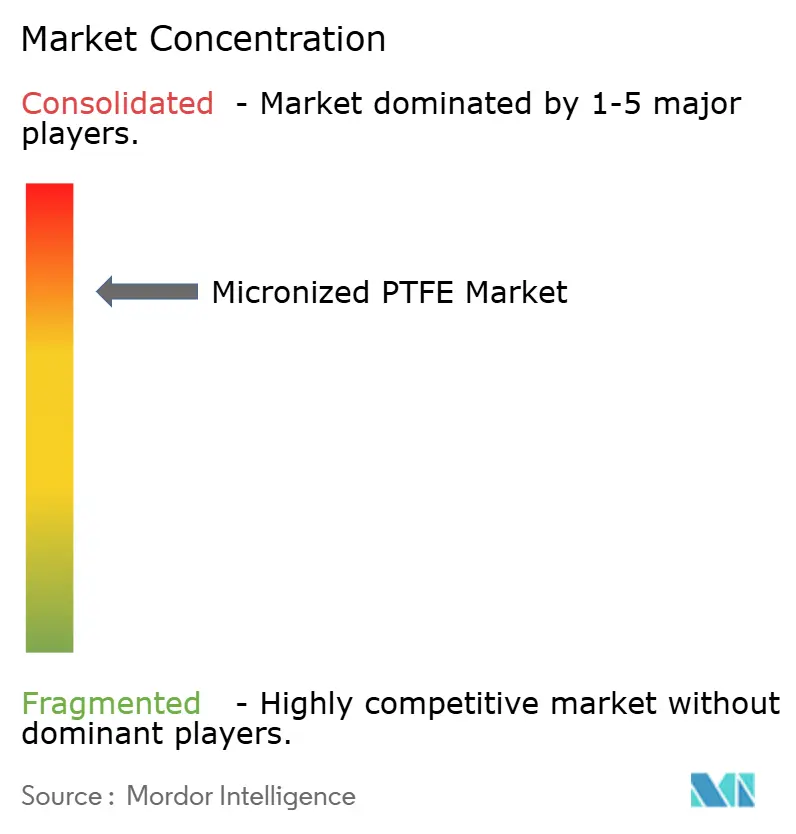


Recent Industry Developments
- November 2024: Micro Powders announced its full withdrawal from PTFE markets by end-2025, redirecting resources to cellulose-based alternatives.
- September 2023: Micro Powders introduced NatureMatte C44, an ultrafine cellulose powder targeting inks and coatings as a drop-in gloss-reduction additive.
Global Micronized PTFE Market Report Scope
The Micronized PTFE Market report includes:
| Inks and Coatings |
| Thermoplastics |
| Lubricants and Grease |
| Elastomers |
| Other Applications (Battery Electrode Binders, etc.) |
| Automotive and Transportation |
| Electrical and Electronics |
| Industrial Processing |
| Medical and Pharmaceutical |
| Packaging |
| Asia-Pacific | China |
| Japan | |
| India | |
| South Korea | |
| ASEAN Countries | |
| Rest of Asia-Pacific | |
| North America | United States |
| Canada | |
| Mexico | |
| Europe | Germany |
| United Kingdom | |
| France | |
| Italy | |
| Spain | |
| Russia | |
| NORDIC Countries | |
| Rest of Europe | |
| South America | Brazil |
| Argentina | |
| Rest of South America | |
| Middle-East and Africa | Saudi Arabia |
| South Africa | |
| Rest of Middle-East and Africa |
| By Application | Inks and Coatings | |
| Thermoplastics | ||
| Lubricants and Grease | ||
| Elastomers | ||
| Other Applications (Battery Electrode Binders, etc.) | ||
| By End-user Industry | Automotive and Transportation | |
| Electrical and Electronics | ||
| Industrial Processing | ||
| Medical and Pharmaceutical | ||
| Packaging | ||
| By Geography | Asia-Pacific | China |
| Japan | ||
| India | ||
| South Korea | ||
| ASEAN Countries | ||
| Rest of Asia-Pacific | ||
| North America | United States | |
| Canada | ||
| Mexico | ||
| Europe | Germany | |
| United Kingdom | ||
| France | ||
| Italy | ||
| Spain | ||
| Russia | ||
| NORDIC Countries | ||
| Rest of Europe | ||
| South America | Brazil | |
| Argentina | ||
| Rest of South America | ||
| Middle-East and Africa | Saudi Arabia | |
| South Africa | ||
| Rest of Middle-East and Africa | ||


Key Questions Answered in the Report
How large is the micronized PTFE market in 2025?
The micronized PTFE market size is valued at USD 0.93 billion in 2025.
What is the forecast CAGR for the micronized PTFE market to 2030?
The market is projected to grow at a 4.44% CAGR between 2025 and 2030.
Which application segment leads the micronized PTFE market?
Inks and coatings lead with 41.34% market share in 2024.
Which region is growing fastest for micronized PTFE demand?
Asia-Pacific is the fastest-growing region, posting a 5.61% CAGR through 2030.
How are regulations affecting micronized PTFE producers?
EU and US PFAS rules are pushing companies to invest heavily in emission-capture systems or exit the market, reshaping competitive dynamics.
Page last updated on:








